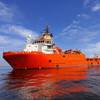Changes in Vessel Operations Protects Whales
Years of study and effort by NOAA and the U.S. Coast Guard will pay off this summer when two changes to shipping lanes into Boston are implemented. Both changes significantly reduce the risk of collisions between large ships and whales.
Beginning on June 1, ships 300 gross tons and above will be asked to avoid an area in the Great South Channel from April through July, when right whales face the highest chance of being struck by ships. The channel is a feeding area for the endangered North Atlantic Right Whale.
Also, ships transiting primarily from the south and entering Boston Harbor in shipping lanes will travel a slightly different path. The north-south traffic lanes have been modified to reduce the threat of ship collisions with endangered right whales and other whale species.
The width of the north-south portion of the lanes will narrow from a total of four miles to three miles. The width of the east-west portion of the lanes was narrowed and modified in 2007.
Implementing the “Area To Be Avoided” and narrowing the “Traffic Separation Scheme” by one nautical mile will reduce the relative risk of right whale ship strikes by an estimated 74 percent during April-July (63 percent from the area to be avoided and 11 percent from the narrowing of the Traffic Separation Scheme).
Slow moving North Atlantic right whales--among the most endangered whales in the world--are highly vulnerable to ship collisions, since their primary feeding and migration areas overlap with major East Coast shipping lanes. Along with existing measures to prevent entanglement of right whales in fishing gear and regulations to reduce ship strikes by slowing ships, these changes in vessel operations are a part of the comprehensive approach that NOAA has taken in its effort to help right whales recover.
“Through years of study we have determined that these changes will likely provide a safer environment for whales and mariners, and at the same time, provide the least amount of disruption and impact to the economy,” said Jim Balsiger, NOAA’s acting assistant administrator for NOAA’s Fisheries Service. “NOAA and our partners are working extremely hard to do all we can to help save this critically endangered species, while helping mariners stay safe and productive.”
Approximately 3,500 ships move through the entire Boston shipping lanes area every year, and more than half of the world’s North Atlantic right whales are known to be in this area during the spring. NOAA researchers used more than 20 years of sighting data to determine the risk of whales being struck by ships in and around the Boston shipping lanes to help develop these changes. Working with the Coast Guard, which assessed safety and navigational effects of ship lane modification to the shipping industry, NOAA proposed the changes to the International Maritime Organization in March 2008.
The International Maritime Organization adopted both of these changes, so they will be reflected on all charts globally and used by the international shipping industry. NOAA’s Fisheries Service is working with NOAA’s Ocean Service and the U.S. Coast Guard to have these changes added to nautical charts and to the U.S. Coast Pilot as well.
“NOAA's scientific expertise and their investment in research into the seasonal distribution of right whales provided the Coast Guard with valuable data and information and helped identify shipping lanes that reduce the likelihood of vessel interactions with this protected species. Fewer collisions involving commercial shipping vessels and right whales will be a great outcome for the agencies, for mariners and coastal commerce and for the public," said Steven Tucker, deputy chief for marine protected species, U.S. Coast Guard Law Enforcement Office.
Existing protective actions also include seasonal and dynamic vessel speed restrictions in selected areas, mandatory lanes into certain ports, surveying whale migration routes by aircraft and mandatory ship reporting systems that provide advisories and information on right whale locations to mariners.












